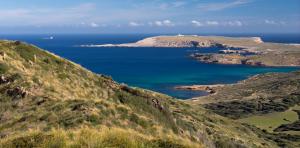
Grants
Sea
Paiños Feeding Areas – Isla del Aire
2.000 € awarded
Organisation Applying for Funding
SOM – Ornithological Society of Menorca
SOM is a non-profit association dedicated to the study, dissemination and protection of birds on the island of Menorca.
Area of Interest
To determine the feeding areas of the European Paiño in the colony on the Isla del Aire.
Summary of the Project
Since 2019 SOM has been intensively monitoring the European Paiño colony (Hydrobates pelagicus melitensis) on the Isla del Aire. During these years it has been possible to monitor its population and to we have learnt the first reproductive parameters of the species on the island. At the same time, projects carried out by the UIB-CSIC have begun in other colonies in the western Mediterranean to find out the feeding areas of these pelagic seabirds via GPS devices.
The first results revealed that Paiños are concentrated in specific points of the sea related to cyclonic gyres of marine currents loaded with nutrients and low salinity after the entry of Atlantic waters from the Strait of Gibraltar. Key areas have been located in the Alboran Sea, off the coast of Murcia and the Algerian coast. These areas have been previously recognised as important spots for other animal species such as cetaceans. In order to migrate to these areas, the Paiños, weighing only 30 grams, during the breeding season, must travel huge distances every 2-3 days, making up a round trip of voer 1,000 kms.
Our project aims to find out which are the most important areas for the colony on the Isla del Aire, the most remote colony of those identifies within the western Mediterranean.
To carry out the marking, we must first locate the nests and select the individuals best prepared to carry the GPS. Since couples switch up every 3 days or so during the incubation period, the device is removed to download data from its journey and placed on another individual to collect new data. Field work, therefore, involves visits to the colony every night for consistent monitoring. The experience and support of the UIB-CSIC staff in recent years has been used to optimise the results.
General Objectives
To obtain detailed information on the movements and feeding areas of breeding European Paiños on Isla del Aire in order to propose protection and conservation measures for the species.
Project Methodology
The placement of tiny GPS devices to track several individual European Paiños in order to find their feeding areas. It is important to know these areas as this will allow a better understanding of their biology and to plan actions for their protection. The main risks to be explored are the impact of structures in the Mediterranean, such as aquaculture farms and wind farms; and the risks caused by dumping. It is important to know how species live in marine reserves in order to suggest the creation of new marine protected areas.
Chronology of the Project
- Commissioning and payment of equipment (January 2021). Equipment must be ordered in advance as it is manufactured specifically for the purpose of the study.
- Several visits to the colony to locate nests and choose the most suitable specimens to carry the GPS devices (April and May 2021).
- Positioning and monitoring of the GPS-equipped birds (June 2021).
- Several visits to monitor the reproduction of the specimens used in the project (July-August 2021).
Collaborations
Support from the team of Dr. Ana Sanz-Aguilar of the Animal Ecology and Demography Group.
IMEDEA (CSIC-UIB)
Applied Zoology and Conservation Group (University of the Balearic Islands).